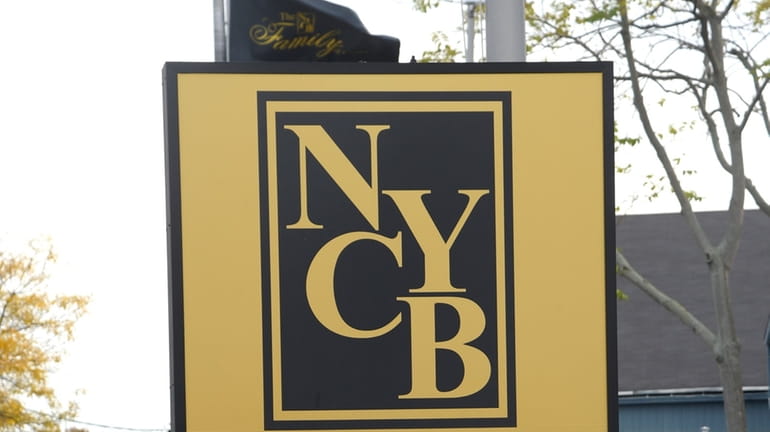NYCB to keep HQ on Long Island, unify brands under Flagstar name after $2.6B merger

New York Community Bancorp says it will eventually rebrand all its banks under the Flagstar name. Credit: Audrey C. Tiernan
New York Community Bancorp. Inc., whose $2.6 billion all-stock acquisition of Flagstar Bancorp Inc. took 20 months to navigate through regulators, will retain its Hicksville headquarters and consolidate its 10 brands under the Flagstar name, officials said.
One federal regulator, the Office of the Comptroller of the Currency, imposed curbs on NYCB's investment in a cryptocurrency payments platform, USDF Consortium LLC, as a condition of approval.
The combination of NYCB and Troy, Michigan-based Flagstar creates an institution with about $90 billion in assets, making it the No. 24 U.S. bank, excluding foreign-controlled entities and investment banks like Goldman Sachs Group Inc., company officials said.
Thomas R. Cangemi, the NYCB president and chief executive who retains those titles in the combined company, said last week that the Long Island bank now sits on the tier below the money-center banks like No. 1 JP Morgan Chase & Co. and "super-regionals" like PNC Financial Services Group Inc
WHAT TO KNOW
- Hicksville-based New York Community Bancorp closed its merger with Michigan-based Flagstar Bancorp.
- Company headquarters will remain on Long Island and NYCB's 10 bank brands eventually will take the Flagstar name.
- Long Island customers initially will see little change as officials plan for integration.
Consolidating operations such as computer systems will take some time, he said.
"It will be business as usual for about a year," Cangemi said, but eventually operations and branding will be unified.
"We'll be one brand, one bank," he said. "Taking it nationwide is the focus."
The unified brand strategy reverses NYCB's practice of allowing many of its acquisitions to operate under their original, local brand.
The combined bank currently operates under 10 brands — New York Community Bank, Queens County Savings Bank, Roslyn Savings Bank, Richmond County Savings Bank, Roosevelt Savings Bank, and Atlantic Bank in New York; Garden State Community Bank in New Jersey; AmTrust Bank in Florida and Arizona; Ohio Savings Bank in Ohio, and Flagstar Bank in Michigan and eight other states.
The company's history stretches back to the founding of Queens County Savings Bank in 1859 and Roslyn Savings Bank, the first savings bank in Nassau County, in 1875.
All told, the post-merger bank operates 395 branches in nine states.
Long Island customers are served by 32 branches in Nassau County and 19 in Suffolk under the Atlantic Bank, Roslyn Savings Bank and New York Community Bank brands, officials said.
Flagstar's mortgage unit, with 81 retail offices, was the seventh largest U.S. bank originator of residential mortgages for the 12 months ending September 30.
NYCB is a leading lender in the New York metropolitan area's rent-regulated apartment house market.
The combined company has about 7,200 employees. In April, Flagstar confirmed that it had laid off more than 400 employees from its mortgage unit amid a slowing homebuying market, according to published reports.
Apart from the mortgage business, officials said post-merger layoffs would be "de minimus" and none would come from "customer facing positions."
Cangemi said he foresees no branch closures.
NYCB and Flagstar twice extended the closing deadline for the merger, announced in April 2021, amid regulatory delays. The deal was closed earlier this month after getting approval from the Federal Reserve Board in November.
In October, the Office of the Comptroller of the Currency approved the deal to create a combined bank with a national charter, but required it to divest its interest in the USDF Consortium within two years unless it gets explicit permission from the agency.
"We view that condition as consistent with the OCC’s well publicized view that banks receive prior approval before engaging in any activities related to digital assets or blockchain," a bank spokesman said in a statement.
NYCB and several other banks founded the USDF Consortium as a payment system. Unlike cryptocurrencies like bitcoin, whose values fluctuate, USDF would be minted by member banks and backed one-to-one by U.S. dollars held by the banks.
The consortium said the USDF system could have uses for mortgage payments, international remittances and app-based payments that could reduce credit card processing fees for merchants.
Trading in Flagstar stock was halted after the deal closed. The merged company trades under the symbol NYCB on the New York Stock Exchange.
In January, during the process of seeking merger approval from regulators, NYCB pledged $28 billion in loans and other programs to benefit minority and low-and-moderate income families and businesses.
"We could do excellent things for society," said Cangemi, who negotiated the deal with the National Community Reinvestment Coalition, a Washington-based not-for-profit.
The five-year pledge hinged on the closing of the merger and came after President Joe Biden signed an executive order urging bank regulators to scrutinize mergers closely.
Alessandro "Sandro" DiNello, former president and CEO of Flagstar, became non-executive chairman of the combined company and Flagstar's Troy, Michigan, base was designated as a regional headquarters.
Updated 17 minutes ago Teacher salaries ... Cold Spring Hills back in court ... SCCC tuition hike ... FeedMe: Omakase Sushi
Updated 17 minutes ago Teacher salaries ... Cold Spring Hills back in court ... SCCC tuition hike ... FeedMe: Omakase Sushi

